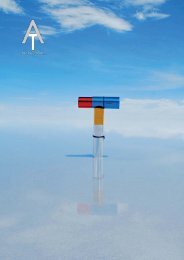Gaston Ugalde - INFO
Art publication with a selection of texts featuring the work of renowned artists Gaston Ugalde
Art publication with a selection of texts featuring the work of renowned artists Gaston Ugalde
You also want an ePaper? Increase the reach of your titles
YUMPU automatically turns print PDFs into web optimized ePapers that Google loves.
Gastón Ugalde: Travel and Landscape
By: Gerardo Zavarce
Curator & Researcher
Gaston Ugalde (La Paz, Bolivia, b.
1944) arrives to the Salar de Uyuni, the
world’s largest salt flat (4,086 square
miles, located in the Potosi and Oruro
departments in Southwest, Bolivia)
through a journey from the city of La
Paz to the core of Bolivia in 1970. This
is not a scientific expedition, as the one
Alexander von Humboldt’s undertook to
the equinoctial America, between 1799
and 1804. On the contrary, what moves
Gastón Ugalde revolves around visual
experimentation becoming central to his
aesthetic progression since the seventies.
Consequently, the images composed by
Gaston Ugalde which incorporate the
Salar’s geography as a stage to produce
a creative experience of the site, inscribe
themselves as a junction field of a
diversity of practices and views about
creation. One the one hand, Ugalde
serves as an uncomfortable heir of the
Humboldtian tradition of the cultivated
Humboldtian landscape along the XIX
century, whose influence has managed
to trace the interstices of time, persisting
to this day and contributing to weave
in a complex manner our strategies to
the understanding and looking at the
discourse about landscape.
where: the perpetual snow, temperate
zones, mountainous areas and vast plains,
make up the landscape’s morphologhy
its discursive alphabet. On this drive
stands a romantic deep imprint about the
territory, it is about the sensible view of
the traveler who seeks -not free of strainsnew
opportunities and horizons.
Notwithstanding, Ugalde who assumes
the experience of travel, of transit as a
focus of his creative process, is also a
disident committed to the image. Then,
through expeditions to the territory of
the Salar constructs a ritual transit that
aims to experience the landscape as a
catalyst of the creation and activation of
the site as sensible proposition, processes
elaborated around an animist reading of
the surrounding. Accordingly, the color
begins to play a fundamental role in the
construction of significant staging that
emerges as alternative visions to articulate
new meanings and build a conceptual
imaginaery and performative from the
place wtihin experimental possibilities
and creators of the visual image.
As a result, through a series of
photographs of the Salar we find
inscribed a vision of the territory as a
built context for interpreting a nature
that is imagined, such as Alexander von
Humboldt and his followers did through
his view of equinoctial America as an
inhospitable and monumental image,
58 59



